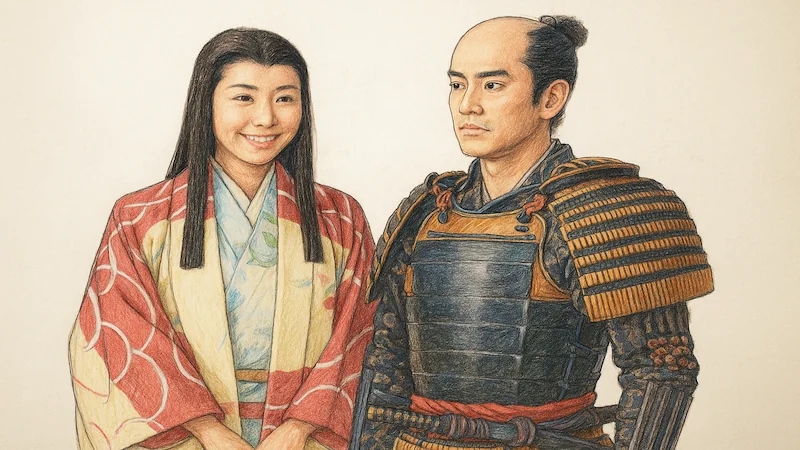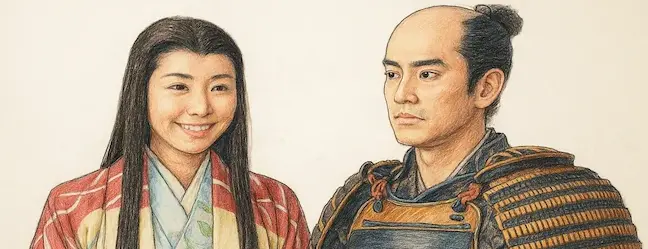
Toshiie and Matsu — The Harmony of Courage and Wisdom
At the heart of Toshiie and Matsu lies the portrait of the couple, Toshiie Maeda and his wife, Matsu. Known as “Spear Mataza,” Toshiie was a brave and loyal warrior, yet not one skilled in political scheming. Portrayed as a man who detested deceit and stood firmly by his principles, his straightforward honesty, though sometimes clumsy, earned him the deep trust and admiration of those around him — a quality that left a strong impression on me.
Matsu, on the other hand, stands out as an exceptionally strong and intelligent woman — rare for her time. Unafraid to voice her opinions before figures like Nobunaga and Hideyoshi, she embodies both intellect and bravery. Far from being just “the supportive wife,” she makes independent decisions to protect her family and people, even taking on political responsibilities. In this sense, she can be seen as a model of leadership that resonates with modern audiences.
Historically, Matsu later acted as a mediator between the Toyotomi and Tokugawa clans and is said to have been involved in peace negotiations before the Battle of Sekigahara. Thus, the drama’s depiction of a woman “fighting her own battles in a different arena” carries a convincing authenticity grounded in history.
The Supporting Cast — The Allure of the Sengoku Ensemble
Beyond the lead couple, the supporting characters in this drama leave lasting impressions of their own.
- Keijirō Maeda: Portrayed as a flamboyant and free-spirited “kabukimono,” he stands out even among the colorful figures of the Warring States. The historical Keijirō was famous for his extravagant dress and unrestrained way of life. In the drama, his wild temperament contrasts sharply with Toshiie’s sincerity, highlighting the diverse personalities within the Maeda clan.
- One (Nene): As Hideyoshi’s wife, One plays a key role in the relationship between Hideyoshi and the Maeda couple. The depiction of her complex relationship with Matsu — alternating between friendship and rivalry — captures both the warmth and tension of female bonds in a male-dominated world.
- Sassa Narimasa, Shibata Katsuie, and Sawa Kiyosuke: Their struggles between loyalty, pride, and survival shed light on the moral complexity of the Sengoku period. In particular, Narimasa’s conflict between faith and self-preservation adds emotional weight, offering a realistic glimpse into the inner turmoil faced by samurai of the time.
The Unforgettable Final Scene — The Tree as a Symbol of Life’s Transience
In the final episode, there is a poignant scene where Matsu visits the tree under which she spent her childhood. After years of war and hardship, the moment is filled with quiet serenity — a calm after the storm of a turbulent life.
“That tree stands just as it did long ago. But a human life passes in the blink of an eye.”
This simple reflection captures the fragility of human life amid the grand sweep of history. It reminds us of the universal truth that because life is fleeting, every moment must be cherished. The quiet beauty of this scene lingered with me long after the episode ended.
The Strength of a Marriage Amid the Fires of War
Toshiie and Matsu distinguishes itself from many historical dramas by focusing not only on battles, but on the bond of trust and mutual support between husband and wife. As Toshiie earns honor on the battlefield, Matsu sustains their family and even engages in political negotiation — a partnership that becomes the very foundation of the Maeda clan’s survival. Through this dynamic, the drama illustrates how the Maeda family endured the chaos of the Sengoku era and later flourished as the lords of Kaga, ruling over a million koku in the Edo period.
This portrayal is consistent with historical record. Even after Toshiie’s death, Matsu was respected by Tokugawa Ieyasu as a key figure in ensuring the Maeda clan’s survival. The drama integrates this historical truth while adding warmth and humanity, crafting a moving depiction of a couple whose loyalty and compassion transcend time.



comment